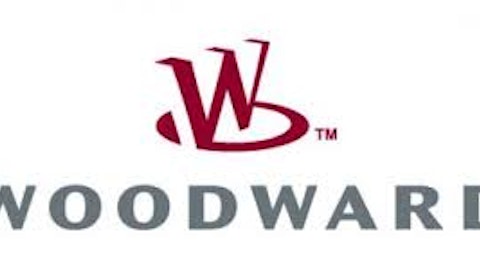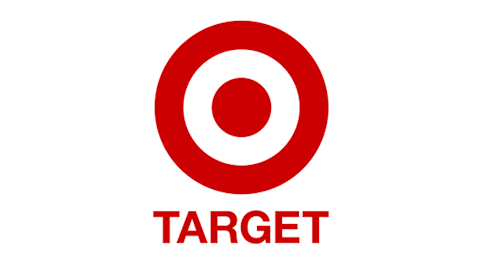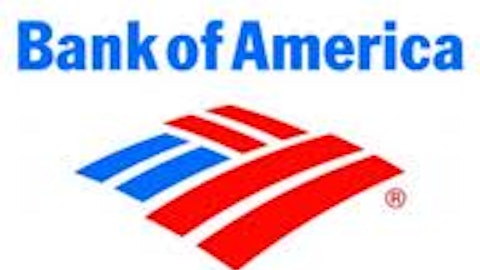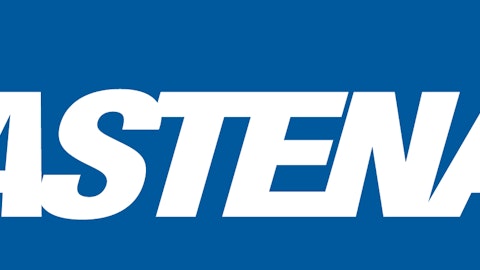The linked quarter increased reflects approximately 2 million from a seasonal increase in medical expense, 1 million in expense as a result of an increase in our stock price and 1 million from higher incentive payments. Our expense discipline and continued focus on operating leverage are reflected on our efficiency ratio on the next slide. As you see on slide 20 solid revenue growth and continued expense control lead to an efficiency ratio below 59 percent. 33 basis points lower linked quarter and 65 basis points lower than prior year. The next 3 slides focus on the transformation of our interest rate risk profile to a more asset sensitive position in anticipation of rising short term rates. Slide 21 summarizes changes to our earning asset mix since 2004, the last time we saw short term rates increase. As you will see we are a much different bank today on both sides of the balance sheet from what we were ten years ago. As a result we feel we are much better positioned for a rising rate environment than ever before.
The numbers shaded in blue show floating rate earning assets have increased from 19 percent to 35 percent of total earning assets since 2004. Also note 85 percent of our commercial real estate portfolio is floating or periodic. Periodic securities CNI and commercial real estate loans typically have 90 day rate resets. The periodic ressie mortgages are primarily 5 and 7 year arms. Slide 22 shows even more dramatic changes on the liability side , transaction accounts have more than doubled and with the addition of the JPM business we’ll compromise 42 percent of liabilities versus 16 percent ten years ago. We’ve also taken actions to lengthen our time deposits and borrowings in fact after we paid down short term borrowings in Q1 the remaining portfolio will have duration of around 2 years. Turing to slide 23, as we have discussed on past calls we have been making a conscious shift to become more asset sensitive and this slide shows the progress we have made .
Here you see our interest sensitivity profile as we get closer to a tightening of monitory policy which we expect to recur later in the year. We have made this shift at minimum cost to our name and net interest income. In fact our name declined only 10 basis points over this time period despite a very challenging rate environment. The HSA acquisition is included in 2014 year end numbers and has added 2 percent for asset sensitivity. We expect to invest about 500 million of the deposits in securities and use remaining proceeds to pay down short term borrowings. In Q4 we have already purchased about half of that and expect to complete the investment program by April. Our asset sensitivity assumes deposits rates react immediately to changes in market rates. A lag in timing of deposit rate increases or a ball twister scenario would improve our results significantly. Turning now to Slide 24 which highlights our Asset Quality Metrix. Non-performing loans in the upper left declined to a 132 million and were .95 percent of total loans. Our lowest level since Q4 of 2007.
New non-accruals were up about 1.5 million to 25 million though noticeably below the prior year level of 40 million. Pass through loans in the upper right also show another quarterly decrease and now represent .29 percent of total loans. Commercial price defined loans in the bottom left increased 13 million and remain in with the recent trend while continue to represent a little over 3 percent of commercial loans. Our annualized net charge off rate of 20 basis points on 6.7 million of net charge offs in the quarter represents the fourth consecutive quarter at or below 25 basis points. The full year charge off rate was 23 basis points compared to 48 basis points in 2013. Assuming recent economic trends remain intact continue improvement in net keys quality matrix is expected as we head into 2015.
By 25 highlights are capital position, the ratios that you see here decline slightly from the levels at September 30 but remain well in excess of the fully phased in Bozzel 3 well capitalized level and our internal targets. Strong asset growth impacted capital ratios this quarter. Tangible common equity was impacted due to a year end pension liability valuation adjustment of 21 million which lowered the ratio by 10 basis points. The decline in tier one comma was driven by strong asset growth. The HSA acquisition will impact this ratio by about another 30 basis points in Q1 and bring us closer to our long term target of 10 percent. Our strong capital position and solid earnings continue to support asset growth, provide for future increases in a dividend of selected buy backs and enable us to confidently pass the annual regulatory severely adverse stress scenario.
Before turning it back over to Jim, I’ll provide a few comments on our expectations for the first quarter. Overall, average interest earning assets will grow onto 3 % which includes security, purchases and connection with the HSA acquisition. We expect average loan growth to be up to approximately 2 % with growth expected to be led by CNI. We expect to see continued pressure on net interest margin and assuming the level of the ten year swap and it’s spread to mortgage rates remaining for this range, we would expect 2 to 4 basis point compression in Q1 driven by lower securities and commercial yields. That being said, we expect an increase of up to one million in net interest income over Q4, driven by loan and investment volume with some losses in compression.
Leading indicators of credit continue to signal further improvement in national equality. Given the outlook for loan growth in Q1, we expect to see a modest increase in the Q1 provision. Regarding non-interest income, We expect an increase of 10 to 11 % over Q4 core level. This is driven primarily by an increase in deposit service fees as a result of our HSA acquisition in addition to higher wealth and investment fees, with some offset from lower loan prepayment revenue. While our expense base will increase by approximately 5 million from the HSA acquisition we will continue to demonstrate a disciplined approach to investing in the business and expect to operate with core operating expenses at a targeted level to keep our efficiency ratio below 60%. Our expected effect of tax rate on a non-FTE basis should be around 33% due to increased earnings and lower tax exempt income. And we expect the average delude share count to be in a range of 90.7 million shares. So with that, I’ll turn things back over to Jim.





